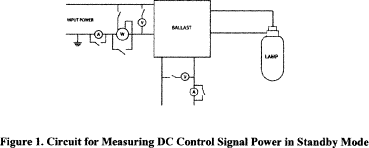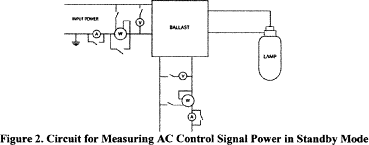Title 10
SECTION 431.324
431.324 Uniform test method for the measurement of energy efficiency and standby mode energy consumption of metal halide lamp ballasts.
§ 431.324 Uniform test method for the measurement of energy efficiency and standby mode energy consumption of metal halide lamp ballasts.(a) Scope. This section provides test procedures for measuring, pursuant to EPCA, the energy efficiency of metal halide ballasts.
(b) Testing and Calculations Active Mode. (1)(i) Test Conditions. The power supply, ballast test conditions, lamp position, lamp stabilization, and test instrumentation shall all conform to the requirements specified in section 4.0, “General Conditions for Electrical Performance Tests,” of ANSI C82.6 (incorporated by reference; see § 431.323). Ambient temperatures for the testing period shall be maintained at 25 °C ±5 °C. Airflow in the room for the testing period shall be ≤0.5 meters/second. The ballast shall be operated until equilibrium. Lamps used in the test shall conform to the general requirements in section 4.4.1 of ANSI C82.6 and be seasoned for a minimum of 100 hour prior to use in ballast tests. Basic lamp stabilization shall conform to the general requirements in section 4.4.2 of ANSI C82.6, and stabilization shall be reached when the lamp's electrical characteristics vary by no more than 3-percent in three consecutive 10- to 15-minute intervals measured after the minimum burning time of 30 minutes. After the stabilization process has begun, the lamp shall not be moved or repositioned until after the testing is complete. In order to avoid heating up the test ballast during lamp stabilization, which could cause resistance changes and result in unrepeatable data, it is necessary to warm up the lamp on a standby ballast. This standby ballast should be a commercial ballast of a type similar to the test ballast in order to be able to switch a stabilized lamp to the test ballast without extinguishing the lamp. Fast-acting or make-before-break switches are recommended to prevent the lamps from extinguishing during switchover.
(ii) Alternative Stabilization Method. In cases where switching without extinguishing the lamp is impossible or for low-frequency electronic ballasts, the following alternative stabilization method shall be used. The lamp characteristics are determined using a reference ballast and recorded for future comparison. The same lamp is to be driven by the ballast under test until the ballast reaches operational stability. Operational stability is defined by three consecutive measurements, 5 minutes apart, of the lamp power where the three readings are within 2.5 percent. The electrical measurements are to be taken within 5 minutes after conclusion of the stabilization period.
(iii) Input Voltage for Tests. For ballasts designed to operate lamps rated less than 150 W that have 120 V as an available input voltage, testing shall be performed at 120 V. For ballasts designed to operate lamps rated less than 150 W that do not have 120 V as an available voltage, testing shall be performed at the highest available input voltage. For ballasts designed to operate lamps rated greater than or equal to 150 W that have 277 V as an available input voltage, testing shall be conducted at 277 V. For ballasts designed to operate lamps rated greater than or equal to 150 W that do not have 277 V as an available input voltage, testing shall be conducted at the highest available input voltage.
(2) Test Measurement. The ballast input power and lamp output power during operating conditions shall be measured in accordance with the methods specified in section 6.0, “Ballast Measurements (Multiple-Supply Type Ballasts)” of the ANSI C82.6 (incorporated by reference; see § 431.323).
(3) Efficiency Calculation. The measured lamp output power shall be divided by the measured ballast input power to determine the percent efficiency of the ballast under test to three significant figures.
(i) A fractional number at or above the midpoint between two consecutive decimal places shall be rounded up to the higher of the two decimal places; or
(ii) A fractional number below the midpoint between two consecutive decimal places shall be rounded down to the lower of the two decimal places.
(c) Testing and Calculations-Standby Mode. The measurement of standby mode need not be performed to determine compliance with energy conservation standards for metal halide lamp fixtures at this time. The above statement will be removed as part of the rulemaking to amend the energy conservation standards for metal halide lamp fixtures to account for standby mode energy consumption, and the following shall apply on the compliance date for such requirements. However, all representations related to standby mode energy consumption of these products made after September 7, 2010, must be based upon results generated under this test procedure.
(1) Test Conditions. (i) The power supply and ballast test conditions with the exception of input voltage shall all conform to the requirements specified in section 4.0, “General Conditions for Electrical Performance Tests,” of the ANSI C82.6 (incorporated by reference; see § 431.323). Ambient temperatures for the testing period shall be maintained at 25 °C ±5 °C. Send a signal to the ballast instructing it to have zero light output using the appropriate ballast communication protocol or system for the ballast being tested.
(ii) Input Voltage for Tests. For ballasts designed to operate lamps rated less than 150 W that have 120 V as an available input voltage, ballasts are to be tested at 120 V. For ballasts designed to operate lamps rated less than 150 W that do not have 120 V as an available voltage, ballasts are to be tested at the highest available input voltage. For ballasts designed to operate lamps rated greater than or equal to 150 W that have 277 V as an available input voltage, ballasts are to be tested at 277 V. For ballasts designed to operate lamps rated greater than or equal to 150 W that do not have 277 V as an available input voltage, ballasts are to be tested at the highest available input voltage.
(2) Measurement of Main Input Power. Measure the input power (watts) to the ballast in accordance with the methods specified in section 6.0, “Ballast Measurements (Multiple-Supply Type Ballasts)” of the ANSI C82.6 (incorporated by reference; see § 431.323).
(3) Measurement of Control Signal Power. The power from the control signal path is measured using all applicable methods described below:
(i) DC Control Signal. Measure the DC control signal voltage, using a voltmeter (V), and current, using an ammeter (A) connected to the ballast in accordance with the circuit shown in Figure 1. The DC control signal power is calculated by multiplying the DC control signal voltage by the DC control signal current.

(ii) AC Control Signal. Measure the AC control signal power (watts), using a wattmeter capable of indicating true RMS power in watts (W), connected to the ballast in accordance with the circuit shown in Figure 2.

(iii) Power Line Carrier (PLC) Control Signal. Measure the PLC control signal power (watts), using a wattmeter capable of indicating true RMS power in watts (W) connected to the ballast in accordance with the circuit shown in Figure 3. The wattmeter must have a frequency response that is at least 10 times higher than the PLC being measured to measure the PLC signal correctly. The wattmeter must also be high-pass filtered to filter out power at 60 Hz.
 [74 FR
12075, Mar. 23, 2009, as amended at 75 FR 10966, Mar. 9, 2010; 79
FR 7843, Feb. 10, 2014]
[74 FR
12075, Mar. 23, 2009, as amended at 75 FR 10966, Mar. 9, 2010; 79
FR 7843, Feb. 10, 2014]